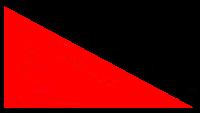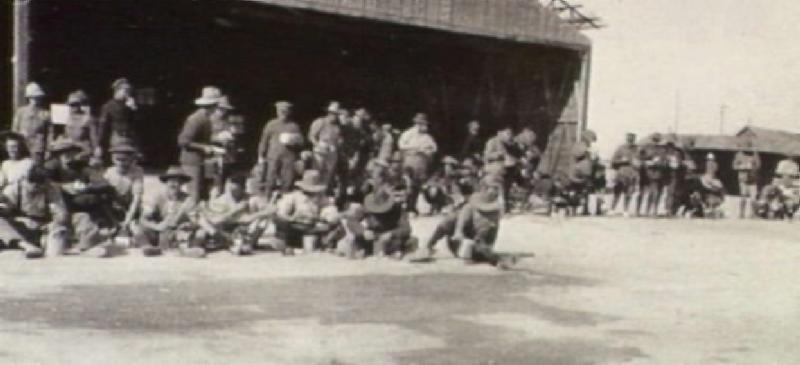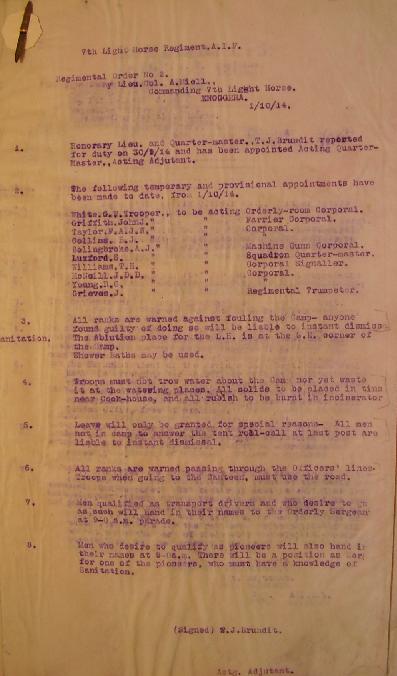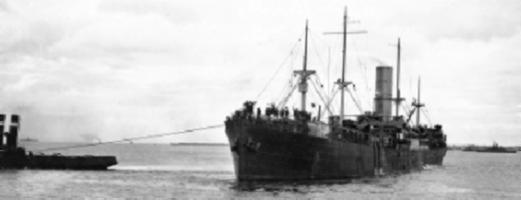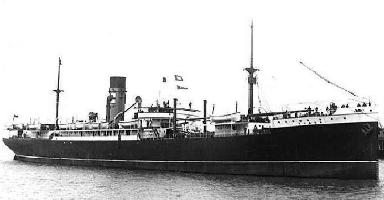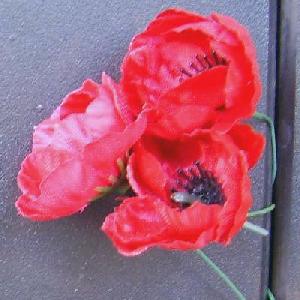The Roll of Honour contains the names of all the men known to have served at one time with the 7th Light Horse Regiment and gave their lives in service of Australia, whether as part of the 7th Light Horse Regiment or another unit.
Leslie John ABBERTON, Died of Wounds, 30 November 1917.
Stanley Frank ALBON, Died of Disease, 21 August 1918.
Ralph ANDERSON, Died of Wounds, 8 June 1917.
Thomas ANDREW, Killed in Action, 6 August 1915.
Alfred Henry BARKER, Killed in Action, 5 November 1917.
James Henry BARTLETT, Died of Wounds, 20 October 1918.
Claude John BATEMAN, Killed in Action, 22 June 1915.
Albert BAXTER, Killed in Action, 16 May 1917.
Neil BEATON, Died of Wounds, 13 October 1915, and subsequently buried at sea.
Valentine Francis BEAZLEY, Killed in Action, 9 August 1918.
William Joseph BEER, Killed in Action, 19 September 1918.
Henry BELL, Died of Wounds, 6 August 1916.
Christie Archibald BENHAM, Killed in Action, 14 November 1917.
Cyril Arthur BENNETT, Died of Wounds, 8 July 1915, and subsequently buried at sea.
Roland Walter BENNETT, Died of Wounds, 22 June 1917.
Henry Norman BILSBOROUGH, Died of Wounds, 29 March 1917.
Arthur William BLACK, Killed in Action, 3 August 1917.
Thomas Harold BLOMLEY, Killed in Action, 6 November 1917.
Francis Patrick Lawrence BOWEN, Died of Wounds, 15 December 1917.
John BRAY, Died of Disease, 2 February 1919.
Terry Patrick BRAY, Died of Disease, 20 November 1918.
Walter Joseph BRODIE, Killed in Action, 8 November 1917.
Lawrence BRUNTON, Killed in Action, 4 July 1918.
Richard BRYANT, Died of Disease, 4 November 1918.
Alfred BUCKLEY, Died of Wounds, 14 March 1918.
Francis Tresilian BULL, Killed in Action, 7 May 1918.
Robert Cumming BUTTERS, Died of Wounds, 5 October 1915.
John CAMPBELL, Killed in Action, 28 June 1915.
John Thomas CAMPBELL, Killed in Action, 9 November 1917.
Roy Daniel CAMPBELL, Died of Wounds, 18 October 1918.
Frederick Wallace CANNAN, Killed in Action, 7 July 1915.
Edward Wilfred CANNONS, Killed in Action, 27 November 1915.
Joseph Leo CARNEY, Killed in Action, 10 October 1917.
Leslie Victor CHANDLER, Killed in Action, 8 August 1918.
Alfred CHAPMAN, Killed in Action, 5 November 1917.
Eric CHENEY, Killed in Action, 30 March 1918.
Raymond Horace CICOLINI, Died of Wounds, 3 June 1918.
Conyers CLIFFORD, Killed in Action, 5 August 1916.
George COLLINS, Died of Wounds, 12 August 1916.
William Galloway CONN, Killed in Action, 12 July 1915.
Roy Egerton COOKE, Killed in Action, 6 August 1915.
Percy Cecil COOPER, Died of Disease, 23 July 1916.
Volney Leonard COOPER, Died of Wounds, 11 July 1915, and subsequently buried at sea.
Arthur Joseph Harold CORBERT, Died of Disease, 11 October 1918.
Augustine COTTER, Killed in Action, 28 June 1915.
Joseph Francis COUGHLAN, Killed in Action, 3 July 1918.
Francis Reynolds COWDERY, Died of Disease, 10 August 1915.
James Paul Gee COX, Killed in Action, 19 September 1918.
William George COX, Killed in Action, 26 September 1917.
Francis Patrick CURRAN, Killed in Action, 4 August 1916.
James DALTON, Died of Disease, 19 December 1918.
Charles Henry DANIEL, Killed in Action, 14 November 1917.
George Douglas DAVIDSON, Died of Wounds, 15 August 1916.
Daniel DeLaHUNTY, Killed in Action, 16 August 1915.
Raymond Francis DEMPSEY, Killed in Action, 5 April 1918.
Leslie Oswald DOBBIE, Killed in Action, 28 June 1915.
Leonard Stanley DOBBS, Killed in Action, 17 August 1917.
Arthur William DRINKWATER, Killed in Action, 5 August 1916.
Thomas Park DUNBAR, Killed in Action, 7 July 1915.
Samuel James DUNKINSON, Killed in Action, 5 August 1916.
Offord William DUPREZ, Died of Wounds, 20 September 1916
Charles Edward ELDRIDGE, Died of Wounds, 25 September 1915, and subsequently buried at sea.
Thomas Patrick ELLIOTT, Killed in Action, 19 July 1916.
Claude ELTON, Died of Wounds, 29 March 1918.
James Hardy FAZIO, Killed in Action, 7 May 1918.
James Herbert FLOWER, Died of Wounds, 25 May 1915, and subsequently buried at sea.
Victor Joseph FOLEY, Killed in Action, 9 August 1915.
Peter Karin FOSTER, Killed in Action, 9 January 1917.
Aubrey Arthur FOWLER, Died of Wounds, 8 January 1917.
Horace Ernest FRAZER, Died of Wounds, 7 August 1916.
Clive Harris FROST, Died of Disease, 1 December 1918.
Edwin George FROST, Died of Disease, 19 October 1918.
Arthur Leeman FULTON, Killed in Action, 7 August 1916.
Stewart Courtney GADEN, Killed in Action, 6 August 1916.
Francis Joseph GANNON, Died of Wounds, 8 July 1915, and subsequently buried at sea.
Thomas GARDINER, Died of Wounds, 3 September 1915, and subsequently buried at sea.
William GEDDES, Killed in Action, 30 July 1915.
William John GEMMELL, Died of Wounds, 26 August 1915.
Arthur Clive GENTLE, Died of Disease, 21 October 1918.
Leslie Eden GEORGE,Died of Accident, 12 May 1918.
Alexander GIBSON, Killed in Action, 19 April 1917.
Horace William GILCHRIST, Died of Wounds, 29 June 1915, and subsequently buried at sea.
William GIRTON, Died of Wounds, 9 November 1917.
Herbert Sherlock GOOCH, Died of Wounds, 21 June 1915.
Milson GOUGH, Died of Disease, 21 January 1917.
George GRAHAM,Died of Accident, 13 January 1916.
Thomas GRAHAM, Died of Wounds, 9 November 1917.
Arthur Alexander GRANT, Killed in Action, 11 April 1917.
William GRAY,Died of Accident, 7 June 1917.
Clement John GRIBBLE, Killed in Action, 22 March 1917.
James Edward GRIFFIN, Killed in Action, 7 July 1915.
Charles Edward GRIMSHAW, Killed in Action, 2 June 1915.
Lambert Adrian GUEST, Died of Wounds, 17 November 1915.
Francis Patrick HALL, Killed in Action, 27 March 1918.
Armitage James HAMPSON, Killed in Action, 20 August 1915.
Thomas McNair HARVEY, Killed in Action, 16 May 1917.
Lawrence HEFFERNAN, Killed in Action, 8 August 1918.
Raymond Charles HENDY, Died of Disease, 9 August 1918.
Rex Edward Steven HEUSTON, Died of Wounds, 7 November 1917.
Victor George HILTON, Died of Wounds, 23 July 1915, and subsequently buried at sea.
Richard George HONEYMAN,Died of Accident, 12 May 1919.
David Matthew JACOMBS, Killed in Action, 17 September 1915.
Harry JOHNSTON, Killed in Action, 8 July 1918.
William JOHNSTON, Killed in Action, 26 May 1917.
Herbert Leslie JONES, Killed in Action, 29 September 1917.
Thomas JONES, Died of Wounds, 25 October 1917.
William Charles JONES, Died of Disease, 8 January 1919.
Oscar KAWLMACKER, Killed in Action, 2 June 1915.
Thomas Llewellen KEEN,Died of Accident, 12 March 1919.
Ernest Edward KELLY, Died of Disease, 11 September 1918.
Alfred KEMP, Killed in Action, 7 June 1917.
Guy Basil KENDALL, Died of Disease, 18 August 1915.
Edward Thomas KEOGH, Died of Disease, 11 March 1919.
David KING, Killed in Action, 27 March 1918.
Ernest John KINKADE, Died of Disease, 9 September 1916.
Edmond KIRBY, Killed in Action, 2 July 1915.
William Henry LACEY, Died of Wounds, 22 November 1917.
Samuel LANGWELL, Killed in Action, 7 May 1918.
Allen John LAVERTY, Died of Disease, 29 December 1917.
James Gordon LAWSON, Killed in Action, 30 March 1918.
Rowland Dennis Clark LEESON, Died of Wounds, 17 October 1918.
Michael LOGAN, Killed in Action, 27 March 1918.
Albert Victor LOUTTIT, Killed in Action, 7 October 1915.
Wilfred Dudley LOVEGROVE, Killed in Action, 6 November 1917.
Herbert Otto LULHAM, Killed in Action, 11 March 1917.
James Edward MacFARLANE, Died of Wounds, 30 July 1918.
Norman Dundonnell MacKENZIE, Died of Wounds, 17 September 1916
Phillip Anslem MADDEN, Killed in Action, 9 November 1917.
Ernest Lindsay MAGILL, Died of Wounds, 20 October 1915.
Edmund Bede MALONE, Died of Wounds, 1 December 1917.
James MARSHALL, Died of Wounds, 15 November 1917.
Thomas MAXWELL, Killed in Action, 7 May 1918.
Thomas James McAREE, Died of Disease, 22 May 1918.
Neil Hamilton McBRIDE, Died of Wounds, 12 January 1917.
William McCARTHY, Killed in Action, 5 November 1917.
William Henry McDONALD,Died of Accident, 5 July 1919.
Jack McFARLANE,Died of Accident, 30 May 1918.
George Francis McGUIRE, Killed in Action, 9 August 1916.
William James McKAY, Died of Disease, 16 August 1915, and subsequently buried at sea.
Montague Charles MELLY, Died of Wounds, 21 September 1916
Francis Frank MILLIGAN, Killed in Action, 26 September 1917.
Harrington Thomas Sterne MITCHELL, Died of Wounds, 30 July 1916.
Harold MOORE, Died of Disease, 28 May 1919.
Reginald George MOORE, Killed in Action, 17 August 1917.
Edwin Hezekiah MORRIS,Died of Accident, 16 August 1915, and subsequently buried at sea.
Frank Robert MORSE-KINCAID, Killed in Action, 9 January 1917.
Harrie Linden MURPHY, Killed in Action, 28 August 1918.
Joseph Henry MURRAY, Killed in Action, 9 January 1917.
William Henry NICHOLLS, Killed in Action, 7 May 1918.
Michael O'LOUGHLIN, Died of Wounds, 11 October 1915, and subsequently buried at sea.
Christopher John PARKER, Killed in Action, 9 November 1917.
Frederick Vance PARKES, Killed in Action, 7 May 1918.
William Arthur PEED, Died of Wounds, 29 March 1918.
Bertie James PEEL, Killed in Action, 7 May 1918.
Leslie PERRY, Killed in Action, 11 December 1915.
Wilfred Mirfield PLASKETT, Killed in Action, 31 March 1918.
Percy POIDEVIN, Killed in Action, 9 November 1917.
Daniel Mallen POLAND, Killed in Action, 6 November 1917.
Ralph POOLE, Died of Wounds, 20 November 1917.
Jack Diamond Sumners POTTS, Killed in Action, 4 January 1918.
Claude Hastings POUNTNEY, Killed in Action, 16 August 1915.
Alfred Edward PRESS, Died of Wounds, 27 March 1918.
Elias Saywell PRYOR, Died of Wounds, 11 December 1917.
Arthur PULLEN, Killed in Action, 26 September 1917.
Wenzel Harold RAYMONT, Died of Wounds, 12 October 1918.
William REID, Killed in Action, 6 November 1917.
Ernest Ambrose ROBERTS, Killed in Action, 17 September 1915.
Mark ROSENBERG, Killed in Action, 5 August 1916.
John Patrick RYAN, Died of Wounds, 9 November 1917.
Roy Edward Francis SADLER, Killed in Action, 14 June 1917.
Herbert Edward SAMUELS, Killed in Action, 9 August 1916.
Milton Harry SEALE, Died of Disease, 26 February 1919.
Alexander John SHERLOCK, Killed in Action, 17 July 1915.
Arthur Thomas SLAVIN, Killed in Action, 25 September 1918.
Archibald SMITH, Killed in Action, 6 November 1917.
Stuart Rutherford SMITH, Killed in Action, 5 August 1916.
William John SMITH, Killed in Action, 30 August 1915.
William Norman SMITH, Died of Wounds, 9 November 1917.
Isaac SNEDDON, Died of Wounds, 12 August 1916.
Francis STANMORE, Died of Wounds, 25 May 1915, and subsequently buried at sea.
Walter STARR, Died of Wounds, 14 August 1916.
Frederick Ladson STEGGLES, Killed in Action, 25 September 1918.
George Grant STEPHEN, Killed in Action, 13 August 1918.
Rowland Clifford STEVENS, Died of Wounds, 30 April 1919.
John William STEWART, Killed in Action, 15 June 1915.
Frederick William STONE, Killed in Action, 30 March 1918.
Reginald Lucian STYLES, Died of Disease, 27 December 1915.
Charles David TAIT, Died of Wounds, 25 January 1916.
Ernest Alexander TAYLOR,Died of Accident, 10 April 1919.
James TAYLOR, Killed in Action, 6 August 1915.
William Thomas TAYLOR, Killed in Action, 21 July 1915.
Lancelot THOMPSON, Died of Wounds, 10 September 1915.
Alan THORNE, Killed in Action, 27 July 1915.
Campbell THROSBY, Died of Disease, 29 February 1916.
Frederick John TIMSON, Killed in Action, 9 November 1917.
Walter Rupert TINK, Killed in Action, 26 March 1917.
Victor TURNBULL, Killed in Action, 7 May 1918.
Charles Eustace TURNER, Died of Wounds, 1 May 1918.
Stanley VILLIS, Killed in Action, 7 August 1915.
Norman WALKER, Killed in Action, 4 December 1916.
William Albert WALKER, Died of Disease, 17 October 1918.
Gordon Hutton WARD, Died of Disease, 1 November 1918.
Francis Stanley WARREN, Killed in Action, 29 January 1917.
William Pickard WASLIN, Killed in Action, 12 November 1915.
John WATERHOUSE, Died of Disease, 20 April 1916, and subsequently buried at sea.
Cyril Anderson WATHERSTON, Killed in Action, 26 May 1916.
Robert Alfred WATSON, Died of Wounds, 10 November 1917 .
Joseph Stanley WELSH, Died of Disease, 2 April 1917.
Aubrey James WETHERALL, Killed in Action, 15 July 1918.
George James WHITE, Died of Disease, 18 October 1918.
Frank WILLIAMS, Killed in Action, 28 April 1917.
Harold Edwin WILLIAMS, Killed in Action, 5 November 1917.
Joseph Enoch WILLIAMSON, Killed in Action, 25 September 1917.
John WILSON, Died of Wounds, 20 September 1915, and subsequently buried at sea.
William John WOODBURY, Killed in Action, 19 October 1915.
Charles Edward WOOTTON, Killed in Action, 9 August 1915.
John Douglas YOUNG, Died of Wounds, 30 June 1915, and subsequently buried at sea.
Matthew O'Grady William YOUNG,Died of Accident, 28 December 1915.
Essington Lowther ZOUCH, Died of Wounds, 17 November 1917.
Lest We Forget
